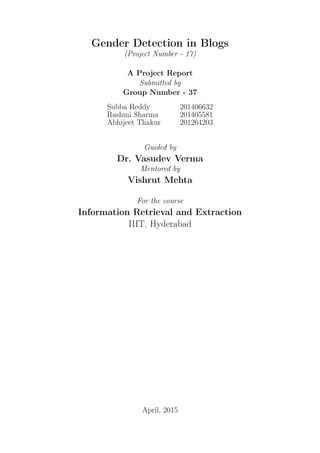SubbuProjectReport
- 1. Gender Detection in Blogs (Project Number - 17) A Project Report Submitted by Group Number - 37 Subba Reddy 201406632 Rashmi Sharma 201405581 Abhijeet Thakur 201264203 Guided by Dr. Vasudev Verma Mentored by Vishrut Mehta For the course Information Retrieval and Extraction IIIT, Hyderabad April, 2015
- 2. 1. Abstract The question addressed in this paper is : given a short text document, can we identify if the author is a man or a woman? This question is motivated by recent events where people faked their gender on the Internet. Note that this is diïŽerent from the authorship attribution problem. Three machine learning algorithms (support vector machine, Bayesian logistic regres- sion and AdaBoost decision tree) are then designed for gender identiïŽcation based on 545 psycho-linguistic and gender-preferential cues along with the stylometric features. Out of these three - support vector machine gives the highest accuracy of 85.1% in gender identiïŽcation. 2. Project Scope The goal of this project is, given a blog, you need to analyze the speciïŽc features in the text diïŽerentiating whether it is written by a male or a female. The features can be anything, for example, if a blog is about dresses, or cats then it may be written by a female, and if a blog is about sports, suits, etc then it would be written by a male. But in this project, you should also analyze the salient features which diïŽerentiate the text content and not merely on the topic of the text. 3. Related Systems âĒ Authorship identiïŽcation : Authorship is calculated by determining if one piece of text contained signiïŽcantly longer words than another. Histograms of word- length distribution were also used for the same. âĒ Gender Guesser : This tool attempts to determine an authorâs gender based on the words used. Submitted text is evaluated based on two types of writing: formal and informal. Formal writing includes ïŽction and non-ïŽction stories, articles, and news reports. Informal writing includes blog and chat-room text. 1
- 3. âĒ Author gender identiïŽcation from text : In a research researchers presented a group of lexical, syntactic and pragmatic features, which would distinguish the language style of women, namely, the use of specialized vocabulary, expletives, tag. 4. Proposed System / Approach âĒ Collecting a suitable corpus of text messages to be the dataset. âĒ Identifying features that are signiïŽcant indicators of gender. âĒ Extracting feature values from each message automatically. âĒ Building a classiïŽcation model to identify the authorâs gender of a candidate text message. Figure 4.1: Gender IdentiïŽcation Process 2
- 4. 5. Dataset We will be using the dataset from the proceedings of PAN 2013 and 2014. The 2013 dataset comprises of blog posts while the 2014 dataset also includes tweets. The original use of this dataset was for the problem of Author ProïŽling; more speciïŽcally determining the authorâs age and gender. Dataset link: http://pan.webis.de/ 6. Evaluation and Analysis âĒ Training Phase : The classiïŽer was trained with 4 diïŽerent number of blogs : 50, 100, 200 and 500. âĒ Testing Phase : In each case, 70% was used for training and 30% was used for testing. Corpus Training Testing Accuracy 100 70 30 70.37% 200 140 60 70% 260 184 76 68.94% 500 350 150 669.76% 7. Conclusion and Future Work By designing appropriate psycho- linguistic and gender-linked features, we observe that word- based features, function words and structural features play important roles in gender identiïŽcation. Experimental results indicate that the identiïŽcation performance is improved by increasing the number of text documents in the training dataset as well as the number of words in each document (e-mail). We ïŽnd that there are signiïŽcant diïŽerences between men and women in personal writings such as e-mails, and gender diïŽerences also exist between authors of news articles even though neutral language is dominant there. 3




